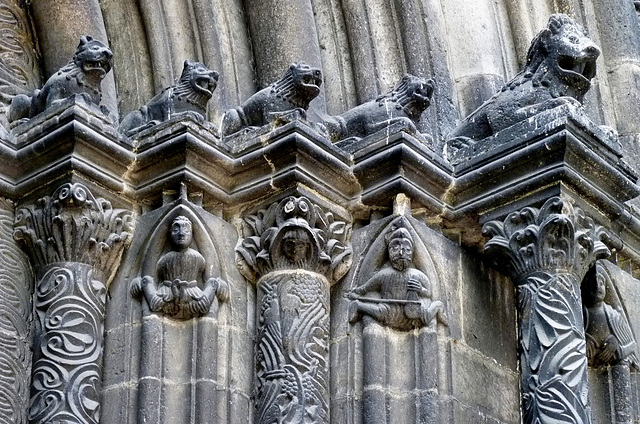Poursay-Garnaud - Notre Dame
Tournus - St. Philibert
Tournus - St. Philibert
Bouhet - Saint-Laurent
Belleville - Abbatiale de l'Assomption
Monreale - Duomo di Monreale
Moudon - Saint-Étienne
Vouvant - Notre-Dame
Vouvant - Notre-Dame
Maillezais - Saint-Nicolas
Matha - Saint-Hérie
Rioux - Notre-Dame de l’Assomption
Rioux - Notre-Dame de l’Assomption
Rioux - Notre-Dame de l’Assomption
Pontevedra - Santa Clara
Location
Keywords
Authorizations, license
-
Visible by: Everyone -
All rights reserved
-
184 visits
Regensburg - Schottenkloster St. Jakob


A Benedictian monastery was founded by Hiberno-Scottish monks in Regensburg already around 1070. Soon after, the convent moved to a place just outside the city walls and in started to erect first buildings.
The first church, consecrated in 1120, was of such a poor workmanship, that the convent decided to tear it down (except one apse and the flanking towers) and restart the process. The church of today was completed before 1200. It is one of the most important Romanesque structures in Bavaria.
The abbey was a hub for the Irish/Scottish mission to central Europe. Daughter establishments of St. Jakob were founded in Vienna (1155), Erfurt (1136), Wuerzburg (1138), Nuremberg (1140), Constance (1142), Eichstaett (1148), Memmingen (1178), Kiev (!) (late 12th century) and Kelheim (13th century).
WHile the first monks and abbots were Irish, the Scottish period started after the Reformation with Scottish abbot Ninian Vincet (1577-1592). A century later Scottish priests were educated here to do missionary work back in Scotland.
Abbot Benedikt Aburthnot (1737-1820) could avoid the secularisation in 1802 by making clear, that the monastery was a Scottish (not at all Bavarian!) national treasure. It took upto 1814 to incorporate the Scottish monastery into the Bavarian sovereignty. Monastic life finally ended here in 1862, when the buildings were taken over by the bishop, who 10 years later founded a still existing seminary here.
The northern portal ("Schottenportal") is one of the most important (and largest) Romanesque works of art in Germany. It occupies a third of the church´s northern wall and is divided into thirds both horizontally and vertically, plus a small frieze that tops the central arch (the vertical center).
While most authors reckon, that Irish masters created this portal, Marcel Durliat sees parallels to works in Northern Italy, created by the Comacine masters ("Magistri Comacini"). He even connects this portal to the carvings in Linden and Remagen. I doubt that..
The right side of the center has five snarling, fierce looking male lions, all having manes. The pillars are elaborately decorated with foliage. The middle-pillar has a bird, pecking grapes, just under the capital, from where a person looks down. There are three persons seen between the pillars (on their knees). The left one may be an acrobat, the middle, bearded one is a musician, playing a small string instrument. The right one, dressed in a kind of cape, holds his hands on his stomach.
The first church, consecrated in 1120, was of such a poor workmanship, that the convent decided to tear it down (except one apse and the flanking towers) and restart the process. The church of today was completed before 1200. It is one of the most important Romanesque structures in Bavaria.
The abbey was a hub for the Irish/Scottish mission to central Europe. Daughter establishments of St. Jakob were founded in Vienna (1155), Erfurt (1136), Wuerzburg (1138), Nuremberg (1140), Constance (1142), Eichstaett (1148), Memmingen (1178), Kiev (!) (late 12th century) and Kelheim (13th century).
WHile the first monks and abbots were Irish, the Scottish period started after the Reformation with Scottish abbot Ninian Vincet (1577-1592). A century later Scottish priests were educated here to do missionary work back in Scotland.
Abbot Benedikt Aburthnot (1737-1820) could avoid the secularisation in 1802 by making clear, that the monastery was a Scottish (not at all Bavarian!) national treasure. It took upto 1814 to incorporate the Scottish monastery into the Bavarian sovereignty. Monastic life finally ended here in 1862, when the buildings were taken over by the bishop, who 10 years later founded a still existing seminary here.
The northern portal ("Schottenportal") is one of the most important (and largest) Romanesque works of art in Germany. It occupies a third of the church´s northern wall and is divided into thirds both horizontally and vertically, plus a small frieze that tops the central arch (the vertical center).
While most authors reckon, that Irish masters created this portal, Marcel Durliat sees parallels to works in Northern Italy, created by the Comacine masters ("Magistri Comacini"). He even connects this portal to the carvings in Linden and Remagen. I doubt that..
The right side of the center has five snarling, fierce looking male lions, all having manes. The pillars are elaborately decorated with foliage. The middle-pillar has a bird, pecking grapes, just under the capital, from where a person looks down. There are three persons seen between the pillars (on their knees). The left one may be an acrobat, the middle, bearded one is a musician, playing a small string instrument. The right one, dressed in a kind of cape, holds his hands on his stomach.
- Keyboard shortcuts:
Jump to top
RSS feed- Latest comments - Subscribe to the comment feeds of this photo
- ipernity © 2007-2024
- Help & Contact
|
Club news
|
About ipernity
|
History |
ipernity Club & Prices |
Guide of good conduct
Donate | Group guidelines | Privacy policy | Terms of use | Statutes | In memoria -
Facebook
Twitter

Sign-in to write a comment.